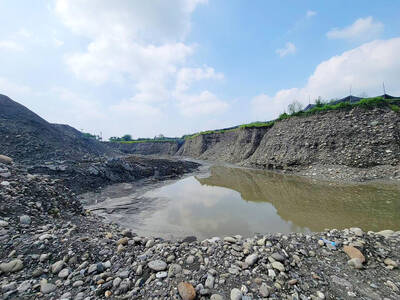It would make the perfect headline: Lady Gaga in an S&M tussle with Andy Warhol. The story would go on to describe, in intimate detail, the dripping of candle wax on Warhol’s naked torso, a whip to keep him in line and plenty of rope to ensure no escape.
Though implausible (Warhol’s been dead for 23 years), the above scene kicks off American Dream Factory (美國夢工廠), the latest play of social criticism by Against Again Troupe (再拒劇團), which begins tonight at Guling Street Avant-Garde Theatre (牯嶺街小劇場).
“It’s the play’s only S&M scene,” said Sammie Liu (劉柏珊), the production’s producer, an hour into a technical rehearsal on Wednesday night.
Pity, that, because Against Again Troupe does such a bang-up job of it — a cross between the gothic atmosphere of Warhol’s Flesh for Frankenstein and the false sexuality of a Gaga video (didn’t she used to be a blow-up doll?).
Directed by Huang Si-nung (黃思農), who co-wrote and workshopped the script with his four actors, American Dream Factory is a mise-en-scene that examines the export of the American dream. Here, however, democratic principles don’t lead to prosperity — the ad nauseum mantra mouthed by a string of recent US presidents.
Today’s American dream export, American Dream Factory suggests, is unfettered capitalism, consumerism and materialism, a dehumanizing product that perpetuates vast inequalities and turns people into automatons. Along with Gaga and Warhol — the latter played by Jack Yao (姚淳耀) of Au Revoir Taipei (一頁台北) fame — the play uses Ronald McDonald, Michael Jackson and Madonna as symbols of the American dream gone wrong.
American Dream Factory began as an art installation for the 2008 Singapore Fringe Festival. The installation comprises the set for the play and requires considerable visual multi-tasking to keep up with. Three televisions showing, for example, footage of Kurt Cobain smashing his guitar and Warhol eating a hamburger, add to the overall theme but also serve as a distraction to the human action. But that’s probably the point.
Though not a particularly original concept (it seems that every month sees a new play in Taiwan attempting to tackle consumerism and materialism as a subject), the fantastical staging of the production makes it an enjoyable ride.

Last week the story of the giant illegal crater dug in Kaohsiung’s Meinong District (美濃) emerged into the public consciousness. The site was used for sand and gravel extraction, and then filled with construction waste. Locals referred to it sardonically as the “Meinong Grand Canyon,” according to media reports, because it was 2 hectares in length and 10 meters deep. The land involved included both state-owned and local farm land. Local media said that the site had generated NT$300 million in profits, against fines of a few million and the loss of some excavators. OFFICIAL CORRUPTION? The site had been seized

Next week, candidates will officially register to run for chair of the Chinese Nationalist Party (KMT). By the end of Friday, we will know who has registered for the Oct. 18 election. The number of declared candidates has been fluctuating daily. Some candidates registering may be disqualified, so the final list may be in flux for weeks. The list of likely candidates ranges from deep blue to deeper blue to deepest blue, bordering on red (pro-Chinese Communist Party, CCP). Unless current Chairman Eric Chu (朱立倫) can be convinced to run for re-election, the party looks likely to shift towards more hardline

Sept. 15 to Sept. 21 A Bhutanese princess caught at Taoyuan Airport with 22 rhino horns — worth about NT$31 million today — might have been just another curious front-page story. But the Sept. 17, 1993 incident came at a sensitive moment. Taiwan, dubbed “Die-wan” by the British conservationist group Environmental Investigation Agency (EIA), was under international fire for being a major hub for rhino horn. Just 10 days earlier, US secretary of the interior Bruce Babbitt had recommended sanctions against Taiwan for its “failure to end its participation in rhinoceros horn trade.” Even though Taiwan had restricted imports since 1985 and enacted

Enter the Dragon 13 will bring Taiwan’s first taste of Dirty Boxing Sunday at Taipei Gymnasium, one highlight of a mixed-rules card blending new formats with traditional MMA. The undercard starts at 10:30am, with the main card beginning at 4pm. Tickets are NT$1,200. Dirty Boxing is a US-born ruleset popularized by fighters Mike Perry and Jon Jones as an alternative to boxing. The format has gained traction overseas, with its inaugural championship streamed free to millions on YouTube, Facebook and Instagram. Taiwan’s version allows punches and elbows with clinch striking, but bans kicks, knees and takedowns. The rules are stricter than the